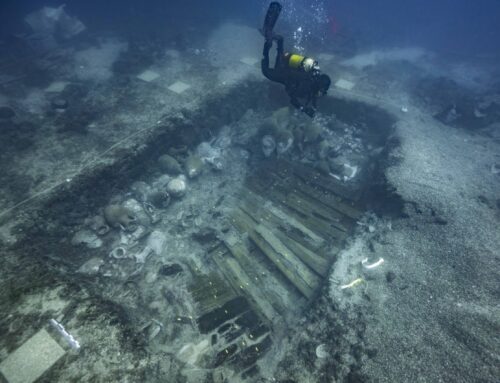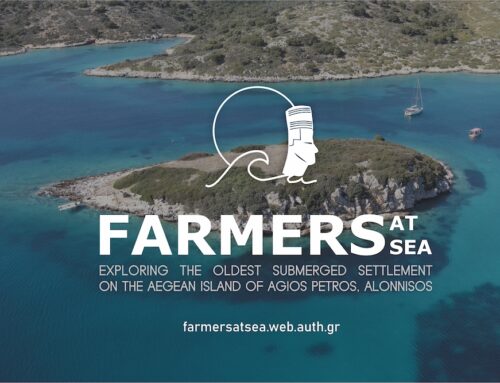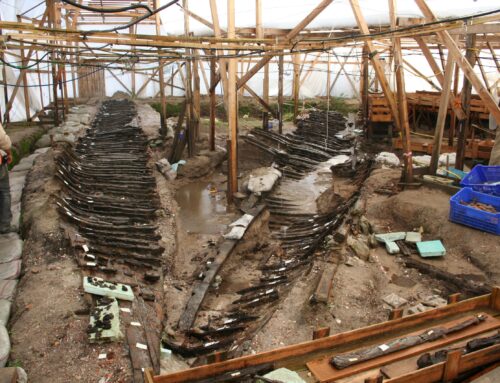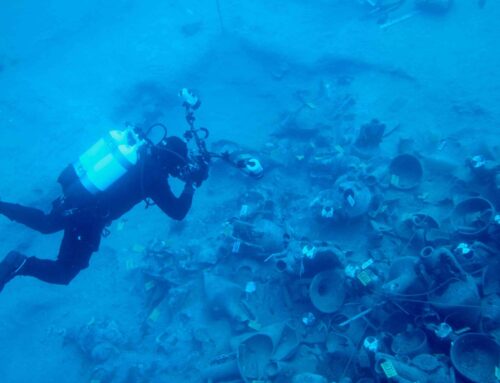The Phoenicians: “The Amazon Prime Of The Ancient Mediterranean”
Dive & Dig Blog by Lauren Tidbury

Honor Frost at Sidon in 1969. Image courtesy of the Honor Frost Archive, Special Collections, University of Southampton.
For episode three of Dive & Dig we wanted to show that maritime archaeology isn’t just about shipwrecks! Throughout the series we have been exploring the Phoencian Shipwreck off Malta being investigated by Timmy Gambin and his team. So we decided to explore the wider Phoenician world, to show the importance of the connection between land and sea and the many other types of sites investigated by maritime archaeologists.
Lucy began by talking to David Abulafia, a professor in Mediterranean history, to help us learn more about who the Phoenicians were. David and Lucy discussed the fascinating world which was being opened up by the Phoenicians through connectivity and seafaring across the Mediterranean and beyond. They also took us to the Phoenician heartland, Lebanon, and discussed the key Phoenician coastal towns of Tyre and Sidon.
Honor Frost worked extensively along the Lebanese coastline and made some of the earliest discoveries of these interfaces of trade and exchange – ports and harbours. Lucy, who was inspired by Honor, focussed her doctoral research on Bronze Age harbours and maritime routes of trade in the eastern Mediterranean. She talked to Bettany about how ancient seafarers began by using natural features as shelter but overtime started to adapt coastlines to reinforce natural shelters. Eventually constructing quays and moles on the seabed and building harbours in exposed locations. Lucy describes these places as amazing melting pots of traders speaking many languages, imagining the hustle and bustle in ancient harbours. Honor was a pioneer of harbour archaeology, focusing mainly on the Levantine coast.
Lucy went on to talk to Claude Serhal who told us about the incredible site of Sidon. It was a naturally protected harbour with a reef connected to the island of Zire. Honor was the first to identify Zire as an offshore anchorage, but she didn’t just focus on the underwater features, she also looked to the coast. She was one of the first archaeologists to recognise the connection between land and sea and the need to look at the big picture, including how landscape changes over time. Honor encouraged the team at Sidon to undertake coring to understand how the landscape had evolved, and how the harbours filled up with silt. Putting sites into context to see the bigger landscape view.
Honor also recognised the significance of rising sea-levels and coastal landscapes becoming inundated. She thought about what the indicators of these changes were and seeing how we can interpret the events of past coastal change. To explore this further the best person to talk to was marine geoarchaeologist, Nic Flemming. He explains how sea levels have changed and that in order to detect sites that are now submerged we need to understand the processes that caused their submergence.
Next we spoke to Jon Henderson about the fascinating site at Pavlopetri in Greece. One of the oldest submerged towns in the world! The site is 5000 years old and so far the team have discovered a town that covers an area equivalent to around eight football fields, which is now under three to four metres of water. Crystal clear waters means you can even snorkel over it and follow this ancient network of streets. The sea is eroding it away, each time the team returns they see something new, which is exciting but also means the site is under threat. It’s an active environment and they need to record what is there before it is lost.
At the end of the episode we returned to Timmy Gambin and talked more about his Phoenician wreck and where he thinks it came from. He searched for parallels when looking at the finds and his colleague Maxine Anastasi helped him to identify the origin of the clay from the ceramics on board. The wreck contains objects from Tunis, as well as objects made on Malta. The ship had clearly stopped locally. Looking at where the objects on board are from is helping them to place this wreck in the wider Phoenician world.
We really enjoyed thinking about this episode and how we could demonstrate the wide range of site types explored by maritime archaeologists, from submerged landscapes, to harbours, ports and coastal settlements. Below are links to the people and sites we discuss if you want to find out more about the Phoenician world.
To listen click here https://audioboom.com/dashboard/5052122
LINKS
David Abulafia – professor of Mediterranean history. David specialises in Mediterranean trade, it’s definitely worth reading his latest book – The Boundless Sea – A Human History of the Oceans.
Claude Serhal – since 1998 has been the Director of the ongoing Sidon excavations (Lebanon), for more information about Sidon check out the project website here. Claude is also a trustee of the Honor Frost Foundation.
Nic Flemming – From 1958 – 1980 used diving with scuba equipment to discover and map subsea caverns formed during the Ice Age low sea levels, and to map submerged classical cities in the Mediterranean. Later, gradually extended research techniques to discover submerged prehistoric settlements and early stone age tools under the sea, culminating in the “Submerged Prehistoric Archaeology and Landscapes of the Continental Shelf “ project 2009 – 2020. He has also recently published his memoir, more information is here.
Jon Henderson is a maritime archaeologist at the University of Edinburgh interested in coastal societies, submerged settlements, lake dwellings and the development of innovative digital techniques for the survey and presentation of underwater sites. More information and some awesome video footage of the Pavlopetri site can be found here.
Timmy Gambin – more on the Phoenician Shipwreck Project can be found here.
To find out more about Honor and her pioneering work on the Levantine coast explore her story map here.





